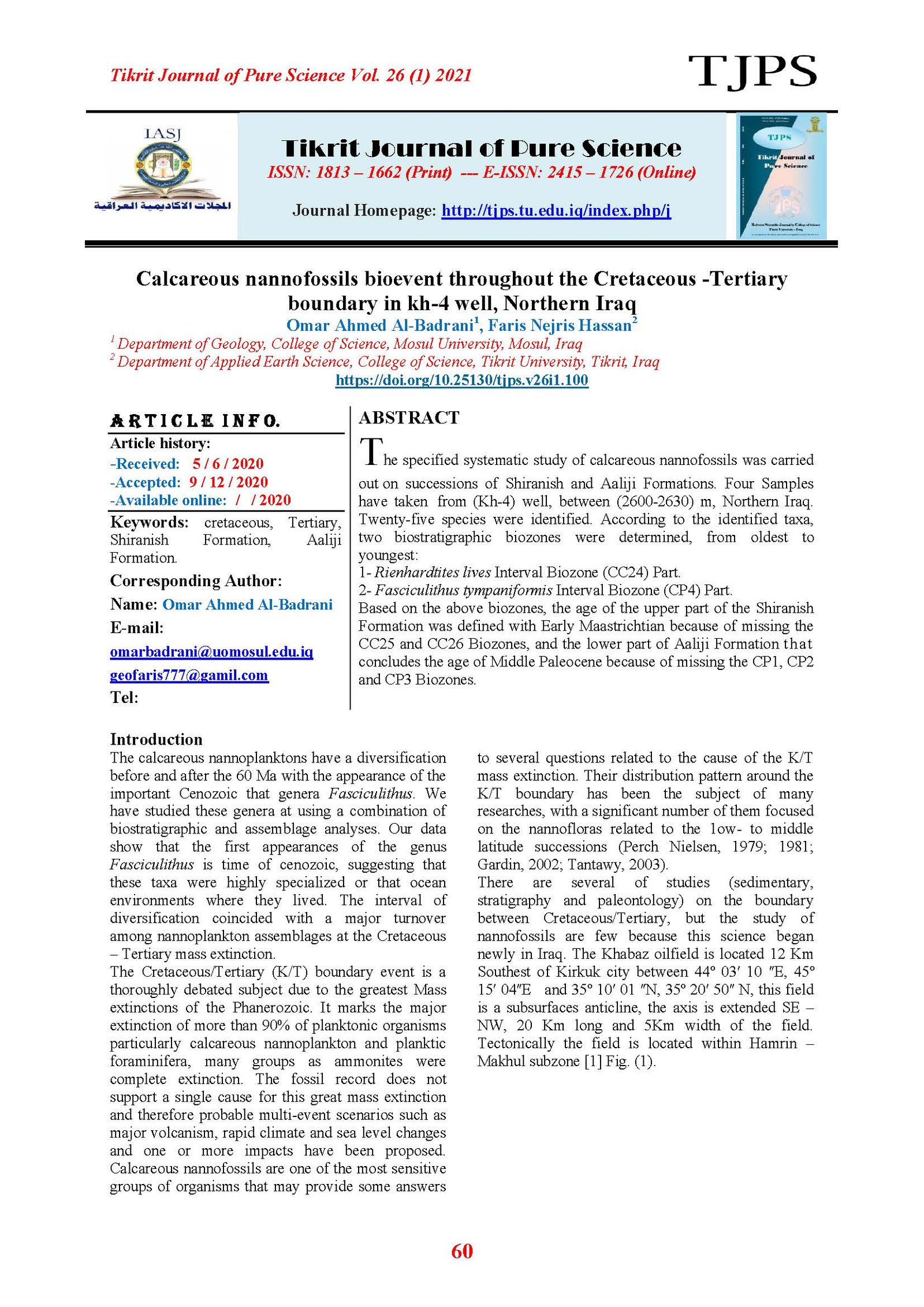Calcareous nannofossils bioevent throughout the Cretaceous -Tertiary boundary in kh-4 well, Northern Iraq
Main Article Content
Abstract
The specified systematic study of calcareous nannofossils was carried out on successions of Shiranish and Aaliji Formations. Four Samples have taken from (Kh-4) well, between (2600-2630) m, Northern Iraq. Twenty-five species were identified. According to the identified taxa, two biostratigraphic biozones were determined, from oldest to youngest:
1- Rienhardtites lives Interval Biozone (CC24) Part.
2- Fasciculithus tympaniformis Interval Biozone (CP4) Part.
Based on the above biozones, the age of the upper part of the Shiranish Formation was defined with Early Maastrichtian because of missing the CC25 and CC26 Biozones, and the lower part of Aaliji Formation that concludes the age of Middle Paleocene because of missing the CP1, CP2 and CP3 Biozones.
Article Details

This work is licensed under a Creative Commons Attribution 4.0 International License.
Tikrit Journal of Pure Science is licensed under the Creative Commons Attribution 4.0 International License, which allows users to copy, create extracts, abstracts, and new works from the article, alter and revise the article, and make commercial use of the article (including reuse and/or resale of the article by commercial entities), provided the user gives appropriate credit (with a link to the formal publication through the relevant DOI), provides a link to the license, indicates if changes were made, and the licensor is not represented as endorsing the use made of the work. The authors hold the copyright for their published work on the Tikrit J. Pure Sci. website, while Tikrit J. Pure Sci. is responsible for appreciate citation of their work, which is released under CC-BY-4.0, enabling the unrestricted use, distribution, and reproduction of an article in any medium, provided that the original work is properly cited.
References
[1] Buday, R.T. and Jassim, S.Z., (1987). The regional geology of Iraq, 2, Tectonism, Magmatim & metamorphism, Baghdad, 352P.
[2] Armstrong, H. and Brasier, M. (2005). Microfossils Black well publishing., p. 296.
[3] Bellen, W.A.; Dunnington, H.V.; Wetzel, R. and Morton, D.M., (1959). Laxique stratigraphique international Asia fascicule 10a – Iraq. Paris, 333P.
[4] Al–Mutwali, M.M., (1996). Planktonic foraminiferal biostratigraphy of the Shiranish Formation, Khashab well (No. 1), Hemren area North eastern Iraq. Rafidain Journal Science, Vol. 7, No. 1, pp. 129–136.
[5] Al-Juboury, F.N., (2011). Planktonic Foraminiferal Biostratigraphy, Depositional Environment and Sequence Stratigraphy of Upper Cretaceous - Middle Eocene Sequences at selected Wells in Khabbaz Oil Field Northeastern Iraq. Un publ. ph. D. Thesis. University of Mosul, 203p.
[6] Robaszynski, F.; Caron, M.; Gonzalez, D.J.M. and Wonders, A.A.H., (1984). Atlas of Late Cretaceous Globotruncanids Revue Micropalentology, fasc. 3– 4, pp. 145–305.
[7] Caron, M., (1985). Cretaceous plankton foraminifera. In Bolli, H.M., J.R. Saunders and K. Perch – Nielaem (eds.) Plankton Stratigraphy, Cambridge University of Press, pp. 17– 86, figs. 37.
[8] Svabenicka, L.; Bubik, M.; Krejci, O. and Stranik, Z., (1997). Sratigraphy of Cretaceous sediments of the Magura Group of Nappes in Moravia (czech
republic). Geologica Carpathica, Vol. 48, No. 3, pp. 179-191.
[9] Sari, B., (2006). Upper Cretaceous planktonic foraminiferal biostratigraphy of the Bey Daglari Autochthon in the Korkuteli area, Western Taurides, Turkey. Journal of Foraminiferal Research, Vol. 36, No. 3, pp. 241–261.
[10] Ardestani, Sh.M. and Mandanizedh A., (2009). Biostrat- igraphic study of the Gurpi Formation based on planktonic foraminifera in Lar area (Kuhe –Kurdeh section), Nature Precedings doi 10/1038, npre. 2947.1.
[11] Al–Mutwali, M.M., (1983). Planktonic foraminiferal biostratigraphy of the Kolosh Formation and contact surface with upper cretaceous rocks in Shaqlawa area, University of Mosul, Unpublished Msc Thesis, 105P.
[12] Sharbazheri, K.M.I., (2007). Biostratigraphy and paleoecology of Cretaceous/ Tertiary boundary in the Sulaimani region, Kurdistan, NE–Iraq. University of Sulaimani, Unpublished Ph.D. Thesis, 159P.
[13] Al- Doory, M. A., (2010). Planktonic foraminiferal biostrastigraphy and deposition environment of Shiranish in Duhok area, University of Mosul, Unpublished M.Sc. Thesis, 120P.
[14] Soran, O. A. Kharajiany, (2019). Calcareous nannofossils biostratigraphy and depositional model of the late Maastrichtian-early Danian succession of Sulaimanah Area, Kurdistan Region/Iraq. Ph.D. Thesis,245p.
[15] Soran, O. A.; Kharajiany Sherwood, W.; Wise, Jr. and Al-Qayim, B. A., (2018). Calcareous nannofossil stratigraphy of the Upper Cretaceous–lower Paleocene sequence from the Dokan section, Sulaimani, Kurdistan- Iraq. Journal of Zankoy Sulaimani- Part A (JZS-A), Vol. 20, No. 2, pp.67-80.
[16] Soran O.A.; Al-Qayim, B. A.; Sherwood W. Wise Jr. (2019). Calcareous nannofossil stratigraphy of the Upper Cretaceous-Lower Paleocene sequence from the Chinarok section, Sulaimani area, Kurdistan Region of NE Iraq. Iraqi Bulletin of Geology and Mining Vol. 15, No., pp. 1-14.
[17] Gafor, A. M., (1988). Planktonic foraminifera and biostratigraphic of Aaliji Formation and contact with Shiranish Formation in well Tal Hager -1, Sinjar area, NW Iraq, Un publ. M.Sc.Thesis . University of Salah aden, 154p.
[18] Abdo, K. S, (1994). Biostratigraphy of Aaliji Formation in Jambor oilfield north Iraq, University of Mosul, Unpublished Msc Thesis, 113P.
[19] Postuma, J.A., (1971). Manual of planktonic foraminifera. Elsevier publication, Amesterdam, 420P.
[20] Toumarkine, M. and Luterbacher, H. P., (1985). Paleocene and Eocene Planktic Foraminifera, In Bolli, H.M., Saunders, J.B., and Perch-Nielsen, K. (eds.), Plankton Stratigraphy: Cambridge University Press, Cambridge, pp. 87-154.
[21] Petrizzo, M.R.; Premoli Silva, I. and Ferrari, P., (2005). Paleogene planktonic foraminifera biostratigraphy, ODP LEG 198 Holes 1209 A, 1210 A, 1211 A Shatsky Rise, Northwest Pacific Ocean Proceedings of the Ocean Drilling Program, Scientific Results Vol. 198, pp. 1-15.
[22] Galal, G. and Kamel, S., (2007). Early Paleocene planktic foraminiferal biostratigraphy at the Monastery of Saint Paul, Southren Galala, Eastern Desert, Egypt. Revue de Paleobiologic, Geneve, Vol. 26, No. 2, pp. 391– 402.
